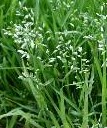 A native of Europe, annual bluegrass is widespread in the United States occurring in all states including Alaska and Hawaii In mild climates it grows from fall to spring and dies in early summer but in cold climates it is a summer annual. Some biotypes of annual bluegrass, however, are actually perennial. Annual bluegrass likes moist, rich soil in full sun or partial shade and is a particular problem in lawns where its flowerheads make the lawn look unkempt and unattractive. It also finds its way into flower beds and vegetable gardens where it can be a nuisance.
A native of Europe, annual bluegrass is widespread in the United States occurring in all states including Alaska and Hawaii In mild climates it grows from fall to spring and dies in early summer but in cold climates it is a summer annual. Some biotypes of annual bluegrass, however, are actually perennial. Annual bluegrass likes moist, rich soil in full sun or partial shade and is a particular problem in lawns where its flowerheads make the lawn look unkempt and unattractive. It also finds its way into flower beds and vegetable gardens where it can be a nuisance.
 Description:
Description:  Annual bluegrass forms clumps of 3-5 stems that can be 4 inches wide and 11 inches tall but tolerate close mowing. The stems are erect or bending and sometimes form extra roots along their base when mature. The leaves are lighter green in color than most turf grasses and measure up to 5 inches long by 1/8 inch wide. They are hairless, folded in the bud, and have a distinctive boat-shaped tip like many other turf grasses. The whitish flowers are produced in 3 inch long open panicles at the tip of the stems. Tiny, brown oval seeds are produced in abundance. The root system is shallow and fibrous.
Annual bluegrass forms clumps of 3-5 stems that can be 4 inches wide and 11 inches tall but tolerate close mowing. The stems are erect or bending and sometimes form extra roots along their base when mature. The leaves are lighter green in color than most turf grasses and measure up to 5 inches long by 1/8 inch wide. They are hairless, folded in the bud, and have a distinctive boat-shaped tip like many other turf grasses. The whitish flowers are produced in 3 inch long open panicles at the tip of the stems. Tiny, brown oval seeds are produced in abundance. The root system is shallow and fibrous.

 Since annual bluegrass reproduces by seed removing the plants before flowering is the best way to control its presence in a garden or lawn. It is easily pulled up in beds and gardens when the soil is moist and mulch will reduce further appearances of the weed there. Severe lawn infestations can profit from repeated mowing to remove seedheads followed by a fall application of pre-emergent herbicides such as benefin/oryzalin, dithiopyr, oryzalin, or prodiamine. Do not use pre-emergent herbicides, however, if you plan to reseed the area immediately.
Since annual bluegrass reproduces by seed removing the plants before flowering is the best way to control its presence in a garden or lawn. It is easily pulled up in beds and gardens when the soil is moist and mulch will reduce further appearances of the weed there. Severe lawn infestations can profit from repeated mowing to remove seedheads followed by a fall application of pre-emergent herbicides such as benefin/oryzalin, dithiopyr, oryzalin, or prodiamine. Do not use pre-emergent herbicides, however, if you plan to reseed the area immediately.